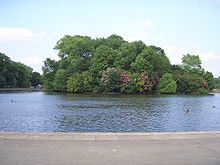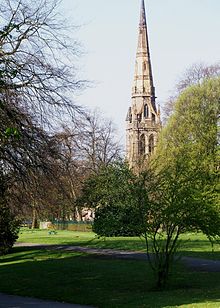- Platt Fields Park
-
Platt Fields Park is a park off Wilmslow Road in Fallowfield, Manchester, England. It is home to Platt Hall, and was originally known as the Platt Estate or the Platt Hall Estate. It is one of Manchester's principal parks, and used to be known as "the lungs of the city".
Contents
Description
The centrepiece of the park is a large pleasure lake, which is used for boating and fishing. The lake has an island sanctuary in the middle, as well as a lakeside visitors' centre and a boathouse.[1] The park also contains part of Gore Brook and part of the Nico (Mickle) Ditch.[2]
There are gardens of different kinds, including community orchard gardens, which contain ferns, roses and heathers. There is also an educational garden and an environmental area, as well as Queen Elizabeth II Jubilee gardens[1] and an Eco Arts garden near to the boating lake. There is a Shakespearean garden located in the Ashfield part of the park in the south east corner that was designed to have only plants mentioned in Shakespeare's works. The Ashfield area also has an arch from the nave of Manchester Cathedral, which was previously located at Manley Hall for a time.[3] Ashfield was added to the park at a later date: it was formerly the site of Ashfield House and was donated to the City by Sir Edward Donner (1839–1934).
There is a labyrinth and picnic area, a Veterans' pavilion and a pair of children's playgrounds.[1] One playground is for toddlers up to age 5, with the other for kids up to the age of 9. Both are located near to the Lakeside Centre.[3] Sports facilities include a pair of bowling greens and courts for basketball, five-a-side, roller hockey, tennis, as well as a mini soccer pitch, cycle pathways and a skate park.[1] A new BMX track was completed at the South end of the park in the summer of 2008.[4][5]
There are three dedicated show fields in the park, which have the infrastructure to host large and small scale national and local events. Events hosted in the park have included the Manchester Mela and Eid Festivals, as well as annual fireworks and bonfire displays.[6] Until 2003 the site hosted the Manchester Flower Show.[2] Facilities-wise, the site has a car park with disabled parking and toilets. The site also has a park office.[1]
Over 43 languages are spoken round the park[7]. It has the oldest Park Friends Group in the country which is named "The Friends of Platt Fields" and was formed in 1992.[8]
Platt Hall
Platt Hall was the home of the Worsley family for 300 years. The current hall, a listed Georgian building, was built by John and Deborah Carill-Worsley to the designs of Carr of York, later moderated by Timothy Lightoler, in 1746 at a cost of £10,000. It replaced a timbered black and white building that had been the home of Charles Worsley, one of Cromwell's lieutenants and Major General for Lancashire, Cheshire and Derbyshire during the interregnum.[9][10]
Gallery of Costume
Platt Hall contains the The Gallery of Costume. The collection spans the era from the 17th century to the present day, covers both men, women and children, and includes both high fashion and the dress of working people. The collection is still growing, and includes present-day designer wear, sports and leisure clothes and underwear.[10] The collection consists of over 20,000 items, and is divided up into a series of themes, which consist of "Designers", "Dressing Up, Dressing Down", "Clothes for Work", "Recycled Fashion", "Sexuality", "Materials and Making", "Close Up", "Sports and Leisure" and "Underwear".[11]
Platt Chapel
The chapel is on Wilmslow Road south of Grangethorpe Road; the present structure is a rebuilding of 1790, then modified in 1874-75. It was a family chapel of the Worsleys of Platt Hall built in 1699, and was constructed for Henry Finch, who had lost the use of the Birch Chapel where he had been installed by the Parliamentarian office Thomas Birch in 1672.[12][13] The congregation began as Independents (Congregationalists) and became Unitarian during the early 19th century. The ministers succeeding Finch were Robert Hesketh, John Whitaker, Robert Andrews, John Houghton, Richard Meanley, George Checkley, Joseph Lawton Siddall, William Whitelegge (1810–1865), S. Alfred Steinthal, and Charles Thomas Poynting.[14][15][16][17]
Since it ceased to be used for worship in 1970 it has been used by various local societies (since 1977). The graveyard, which used to be larger, is surrounded by Platt Fields Park.[18]
History
The first known mention of the area is from 1150, at which time the "lands of Platt" were given to the Knights of St John by "Matthew, Son of William". Gore Brook is mentioned as being present at the time. The Platt family obtained the estate in 1225, and owned the land for the next 400 years. In 1625 it passed to the Worsley family, and was then a country park bordering on the Cheshire Plain, and called the Platt Hall Estate. The park was landscaped by William Emes in 1768[19]. The Worsley family owned the estate until 1907.[2]
Church of the Holy Trinity from Platt Fields Park
By the early twentieth century, the site was a country park with a mansion, though the estate was gradually surrounded by ever-increasing housing, causing Elizabeth Tindal-Carill-Worsley to put the estate on the market in 1907. It soon became apparent that the park was at grave risk of being sold for development and there was even mention of tearing down the Hall and using the bricks for housing. William Royle was prominent in mobilising support for the Corporation to purchase the estate in order to save the park and house for future generations. This led to the Lord Mayor of Manchester calling a town meeting, at which it was decided to purchase the estate for public parkland, leading to its purchase in 1908 at a cost of £59,975.[2]
During a time of high unemployment during the winter of 1908 and 1909, over 700 men relaid the park, including planting banks with shrubs and trees, diverting the Gore Brook and creating a lake and island covering just over 6 acres (24,000 m2).[2] Local legend speaks of a tunnel running from the boathouse, underneath the lake (only a few feet deep) to somewhere on the island.[citation needed] The park, named Platt Fields Park, was formally opened on 7 May 1910 by the Lord Mayor of Manchester, Sir Charles Behrens. At some point over the following five years, a half acre paddling pool was constructed. The park was used for a variety of sports, including tennis, football, bowling and cricket. More work was carried out during another time of high unemployment, between 1919 and 1925, when the park and playing fields were levelled, and bowling greens and tennis courts were constructed, as well as a bathing pool. A Speakers' Corner was once located near to the adjacent Holy Trinity Platt Church.[2]
The park had a tennis pavilion, which was built in 1926, but was demolished in January 2006 after being empty for several years while waiting to be converted for use by disabled children by the Social Services Department.[7] The park also used to have a Pets Corner and Animal Park, as well as a children's playground, a cafe, and rose gardens and herbaceous borders.[7] Part of pets corner was actually set in a rectangular sunken area. This area was the open air swimming pool.[citation needed][20]
See also
References
- ^ a b c d e "Facilities in Platt Fields Park". Manchester City Council. http://www.manchester.gov.uk/site/scripts/documents_info.php?categoryID=200073&documentID=1502&pageNumber=3. Retrieved 2008-04-18.
- ^ a b c d e f "History of Platt Fields Park". Manchester City Council. http://www.manchester.gov.uk/site/scripts/documents_info.php?categoryID=200073&documentID=1502&pageNumber=4. Retrieved 2008-04-18.
- ^ a b "Friends of Platt Fields — Park Features". http://www.plattfields.org/stuff.htm. Retrieved 2008-04-19.
- ^ "Friends of Platt Fields — A BMX Track?". http://plattfields.org/stuff.htm#sports. Retrieved 2009-02-09.
- ^ "Manchester BMX track updates". http://www.manchesterbmx.co.uk/WebPages/trackbuild.html. Retrieved 2009-02-09.
- ^ "About Platt Fields Park". Manchester City Council. http://www.manchester.gov.uk/site/scripts/documents_info.php?documentID=1502. Retrieved 2008-04-18.
- ^ a b c "Friends of Platt Fields — Parks and Platt Fields". http://www.plattfields.org/platt.htm. Retrieved 2008-04-19.
- ^ "Friends of Platt Fields". http://www.plattfields.org/. Retrieved 2008-04-18.
- ^ "Platt Hall". Manchester City Council. http://www.manchester.gov.uk/site/scripts/documents_info.php?categoryID=200073&documentID=1502&pageNumber=5. Retrieved 2008-04-18.
- ^ a b "Manchester City Galleries — The Collection — Gallery of Costume". http://www.manchestergalleries.org/our-other-venues/platt-hall-gallery-of-costume/the-collection/. Retrieved 2008-04-18.
- ^ "Manchester City Galleries — Gallery of Costume — Collection Themes". http://www.manchestergalleries.org/our-other-venues/platt-hall-gallery-of-costume/the-collection/collection-themes/. Retrieved 2008-04-18.
- ^ http://www.british-history.ac.uk/report.aspx?compid=41429
- ^ Whitehead, David, "Birch, Thomas", on the website of the Oxford Dictionary of National Biography (Subscription or UK public library membership required), http://dx.doi.org/10.1093/ref:odnb/66520
- ^ http://www.archive.org/stream/lancashirenonco05nighuoft#page/154/mode/2up
- ^
 This article incorporates text from a publication now in the public domain: "Andrews, Robert". Dictionary of National Biography. London: Smith, Elder & Co. 1885–1900.
This article incorporates text from a publication now in the public domain: "Andrews, Robert". Dictionary of National Biography. London: Smith, Elder & Co. 1885–1900. - ^ http://www.coghlan.co.uk/Letters/whoiswho.htm
- ^ http://www.archive.org/stream/registerofgradua00univuoft#page/284/mode/2up
- ^ Hartwell, Clare et al. (2004) Lancashire: Manchester and the South-East. (The Buildings of England) New Haven: Yale University Press ISBN 0-300-10583-5; p. 469
- ^ Bostock, T "Oulton's Historic park and garden", Cheshire History, 44 (2004–2005) pp. 48–61
- ^ http://www.plattfields.org/history.htm
External links
- Gallery of Costume - official site
- http://rusholmearchive.org
Categories:- Parks and commons in Manchester
- Grade II* listed buildings in Manchester
Wikimedia Foundation. 2010.




